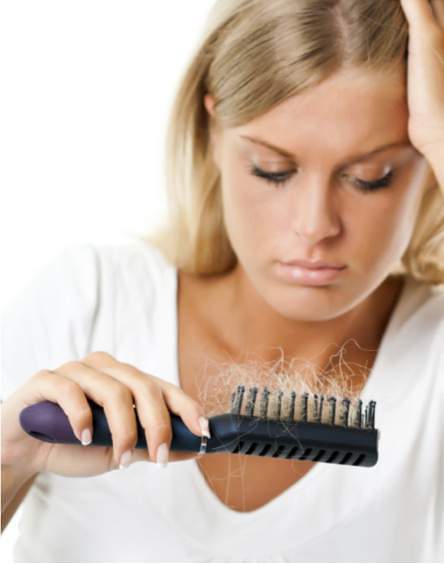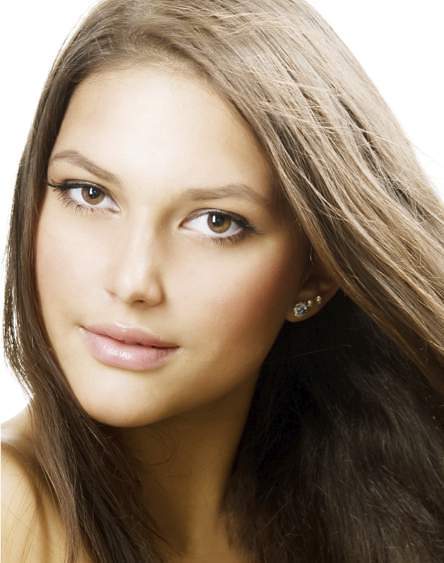causes and types of hair loss in women




"Hair loss can
happen at any
time of life,
for a number
of reasons"
"Hair loss can
happen at any
time of life,
for a number
of reasons"
"Hair loss can
happen at any
time of life,
for a number
of reasons"
causes of hair loss in women
A survey of over 1000 women found that a staggering 33% (or 1 in 3) reported hair loss. This was observed as an increase in the amount of hair shed or a reduction in the length grown, both of which contribute to a reduction in hair volume if the problem persists for any length of time.
Hair volume varies between individuals with some people having finer (or thinner) hairs than others. As we grow older, there is a tendency for our hair fibres to become finer and shorter over successive hair cycles, but years may elapse before any obvious difference is seen.
Hair volume is determined by three factors:
- the number of hairs present per square centimetre
- the proportion of hair follicles in the growing phase
- hair fibre thickness
Almost all hair problems show up as a change in one or any combination of these three factors. Understanding what has changed is the key to identifying the underlying cause.
It is important to understand that 95% of hair loss complaints seen in women are caused by just two conditions. These are:
- Chronic telogen effluvium (CTE)
- Genetic hair loss (androgen-dependent alopecia)
Both of these are covered in detail on this website and the causes of the remaining 5% of cases are also summarised.
what type of hair loss do I have?
If you think you have increased hair shedding, then you should use the interactive chart to help you determine what the cause might be. Since there are effectively only two main types of hair loss, CTE and Genetic Hair Loss, it is likely that your hair loss problem is due to one of these complaints.
The two conditions have similar symptoms but can be distinguished from each other by identifying which area of the scalp is affected.
If after using the chart you think you may have CTE, click here. If on the other hand, you feel your hair problem is the genetic type of hair loss, you should click here.
other types of hair loss
95% of hair loss complaints seen in women are caused by one of two problems: Chronic Teleogen Effluvium (CTE) and Genetic Hair Loss. This next section deals mainly with Genetic Hair Loss and the remaining 5% of causes are also summarised.
Genetic Hair Loss
The most common hormonal hair loss problem affecting men and women is primarily genetic in origin (androgen-dependent alopecia or male pattern baldness). In this situation, the inherited tendency towards hair loss is activated by a change in the hormonal balance within the scalp and hair follicle (the precise mechanism is as yet unknown).
Whilst CTE results in diffuse hair loss across the whole scalp, genetic hair loss extends from just behind the front hairline back across the top of the head to the crown area. This hair loss makes the scalp more visible and, if you have a parting, this will often look wider. A further difference is that unlike CTE, which is generally not apparent to other people, genetic hair loss is generally noticeable to others.
The onset of genetic hair loss is usually during the mid to late 20’s. Effective medical treatment is available and usually involves oral anti-androgen and oestrogen therapy. Women requiring such treatment do require a referral to a medical specialist. Under such medical supervision, they can often re-grow up to 40% more hair .
Post-Menopausal
While early adolescence and the mid to late 20’s are potential problem times for women susceptible to genetic hair loss, the menopause is an equally critical time. This is because there is a natural reduction in the level of oestrogen (female hormone), resulting in a change of the balance between the oestrogen and androgen (male hormone). Consequently further hair loss is experienced or those previously unaffected by genetic hair loss during the menstrual years become affected.
Anecdotal data suggests that some current types of HRT induce hair changes similar to those seen in genetic hair loss, although some women notice improvements as a result of oestrogen levels being restored.
Thyroid
Thyroid imbalances can produce significant changes in hair growth and hair quality . In the UK approximately 2% of women and 0.1% of men are affected. Only a blood test can diagnose this condition. The frequency of hypothyroidism (under active thyroid) increases significantly after the menopause, when up to 10% of women may be affected.
Pregnancy
It is well established that following childbirth 50% of women experience post-natal hair loss and this usually regrows without intervention. In those few women where it does not other reasons can normally be found. The precise cause of post-natal hair loss is unknown although some hormonal and nutritional factors have been identified.
If you suffered in one pregnancy you may not after a second or subsequent pregnancy and vice versa.
Illness
General health disturbances can cause increased hair shedding 10 to 12 weeks after the start of the problem. The hair loss usually continues for a week or longer than the time of the illness. No treatment is required unless other complications develop. Sometimes additional shedding ensues due to the medication(s) given, or if prolonged fever is associated with the illness.
Other medical conditions
There are a number of other medical conditions and diseases causing hair loss. These all require medical attention. Perhaps the most common is the loss of hair in patches, called alopecia areata (AA). Although the frequency of AA is relatively small (about 0.1% of the population) it is a condition that receives a great deal of media attention. In its most severe form total loss of scalp and sometimes body hair, can occur. Most sufferers however only develop a few isolated patches, which correct themselves without any treatment. Since the cause of AA remains unknown there is no specific treatment as yet. Current research is focusing upon the immune system which looks like leading to a better understanding and hopefully an effective treatment.
which hair loss type best describes your situation?
Use the interactive flowchart below, if you have noticed hair loss or if you think your hair is thinner than it used to be. Simply select one of the buttons shown at each stage, to navigate around the chart.
